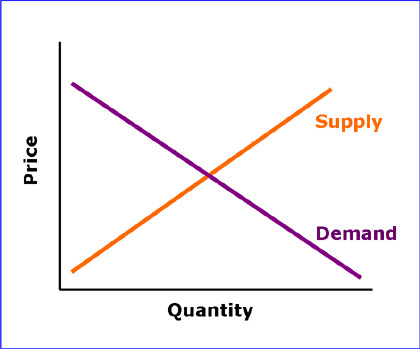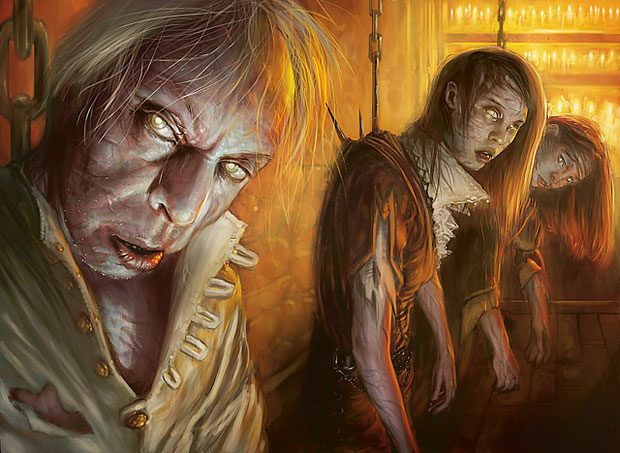
Magic: The Gathering is a popular trading card game created by Richard Garfield PhD and is currently under Wizards of the Coast, a subsidiary of Hasbro. I have personally been a player for 2 years now but one of the most fascinating aspects of game would be the secondary market and its mirrors to microeconomics. The following will be a guide on using the popular trading card game and its secondary market to understand a basic economic concept.
Demand and Supply

Demand and Supply are the essential push and pull forces of an economy. They share an inverse relation, when demand goes up, supply diminishes while supply increases, demand decreases. This is often the cause for changes in prices. Since this game's economics are run by the secondary market, it adheres to this "Supply and Demand Law".
Examples of Demand

The change in demand could be shown in positive and negative aspects. A positive change in demand would lead to more cards being sold, meaning lesser supply and in the end, an increased price. This can be depicted by the price change with Heartless Summoning, as it saw extensive tournament play in the popular Heartless Eldrazi deck. Thus, this card went from bulk to gold!

An example of demand negatively affecting the price of a card would be a banning and closings of markets. A recent example of bans would be the banning of Splinter Twin and Summer Bloom. These two were key components in Modern decks that focused on these two cards to accomplish combos.

Because of the banning of these cards, the decks have effectively shut down, leading to lesser demand for these cards in the format.

Next, we have the closings of markets. This is shown by prices being negatively impacted by entire formats being irrelevant. This is proven by looking at staples at the now unpopular Tiny Leaders format. It is entirely possible that certain formats with high barriers of entry such as Legacy or Vintage will shut down due to Wizards' more cutthroat approach towards proxies (as some stores would allow proxies in unsanctioned events). A proxy is a copy of a card not officiated by Wizards of the Coast while depicting the likeness of an existing card. This may lead to an eventual decline of certain staples in the formats. However, due to the popularity of EDH, this may not be the complete case.
Examples of Supply

Here is how supply could affect the economy negatively or positively. Hasbro reserves the right to print more of a product if there is a supply issue, as long as it follow rules given by itself such as The Reserve List and implemented quotas to ensure a healthy economy. This happened in the Commander 2013 deck series with True-Name Nemesis. The low supply lead to a heightened price, in order to remedy this, Wizards allowed for the reprint of the Commander product as standalones rather than sets of 5 as initially marketed. The increase of supply as stores feel less hindered upon buying stock, lead to a price stabilisation.

There could also be a forced lack of supply which drives up prices. This can be seen by buyouts of certain cards hoping for a price increase (with just a bit of demand, it could go up exponentially), I am looking at you Seance Guy. For those who do not know, he paid people to incinerate their copies of a fringe unplayable card called Seance, most likely purchasing a lot for himself (Either that or it was a twisted social experiment). The control of supply is especially the case when card sharks post up extremely competitive buylist prices at limited advanced level events. As this is an effort for them to build stock to fix prices.
Now, how to use this knowledge to improve your Magic: The Gathering financial experience?
#1 - Bulk Rares
This comes from personal experience with the Heartless Summoning craze. This card was seemingly bulk but it was bulk waiting to be broken. I knew this as there were many other combos that could be played with this card. What surprised me was how effective was the Eldrazi that Battle For Zendikar brought to the table. So, look into your bulk folder, find something that you feel could be broken just by a new card printing, bonus if it is supplemented by an existing card or cards. Supply may be high as everyone stuffed them in their bulk folder but if demand exceeds supply, you've got yourself a price spike.
#2 - Observation

If you are patron to big events like GPs or Pro Tours, look out for buylists on the floor. Most importantly, go up to the featured match area and see what the pros are playing. If the pros are winning, odds are the price of the cards they are playing will go up. Why? Demand of course!
#3 - Be careful

Be careful of card sharks. They wait to pounce on any rare you have for offer. Make sure to properly understand why the demand for the card is there and if you have the patience, wait and see if it grows. However, keep in mind that the more you wait, the riskier it is.
#4 - Invest in the Reserve List

Even though Legacy and Vintage may be on its way to the execution block, investing in the reserve list is one of the best strategies for any MTG financier. You may ask, "Wouldn't demand go down with the two formats dead?" Have you forgotten EDH? Since it is a casual format, it can't die, especially with the massive amount of support Wizards is giving them. Why should you invest in the Reserve List (especially high value EDH playables)? Because supply is restricted and even the company that prints the cards can't do anything about it! As the game ages, as players increase, since supply remains the same while demand goes up, the price would also go up. However, keep note that there are still some minute risks that could arise as the game evolves as the presence of the reserve list may not be entirely an absolute. So be wary, it is one of the safest bets but it isn't 100% foolproof.
Even in the case of Black Lotus, which would be in no formats should Vintage die, it will maintain its price due to its symbolic nature as the gold standard of Magic.
TL;DR for non-players
If you are not a player of this game, kudos to you to getting past everything on top. If you skipped right down here for the summary as you don't understand all the game jargon that is fine too.
Basically, Demand and Supply are the main driving force of any micro-economy. Some assets may look crap but are secretly gold just waiting for the right time. Observation is key in any financial market. And finally, don't get conned, everyone wants to benefit off you, so if a deal is too good to be true, it may be just so.
Sharing is Caring,
Sean Wang


Your first graph should have supply regressing to a horizontal line to accurately portray the fact that there is a finite # of copies of cards. This would also accurately depict why cards spike so much at higher prices.
ReplyDeleteThe graph was a generic supply demand graph i got online
Delete